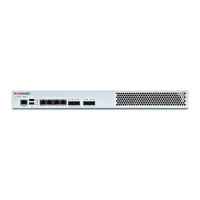Optional Services Persistent Routing
Non-NAT is commonly used on Private Network and MPLS network, which makes possible for the hosts of the branch
office to directly access the headquarters. In case that ISP 1 is down, FortiWAN will automatically route the link to ISP
2, and, accordingly, serve as VPN load balancer based on the status of each link.
Persistent Routing
Persistent routing is used to secure subsequent connections of source and destination pairs that are first determined
by Auto-Routing in FortiWAN. It is useful for applications require secure connection between the server and client
whereby client connection will be dropped if server detects different source IP addresses for the same client during an
authenticated and certified session. PR ensures that the source IP address remains unchanged in the same session.
Timeout: For every session (pair of source and destination), if there is no packets occured during the timeout period,
records of persistent route of the session will be cleared. That means the next coming connection of the session will be
routed by the auto-routing rules first.
FortiWAN provides mechanisms to record, notify and analysis on events refer to the Persistent Routing service, see
"Log" and "Statistics: Persistent Routing".
IPv4/IPv6 Web Service Rules
Sets persistent routing rules on Web services. Enable this function, and all the http and https connections established
from source IP specified below to destination port 80 and port 443 are governed by Web Service Rules.
E : Check the box to enable the rule.
When :
Options: Busy hour, Idle hour, and All-Time (See "Busyhour Settings").
Source :
Established connections from the specified source will be matched (See "Using the web
UI").
125 FortiWAN Handbook
Fortinet Technologies Inc.

